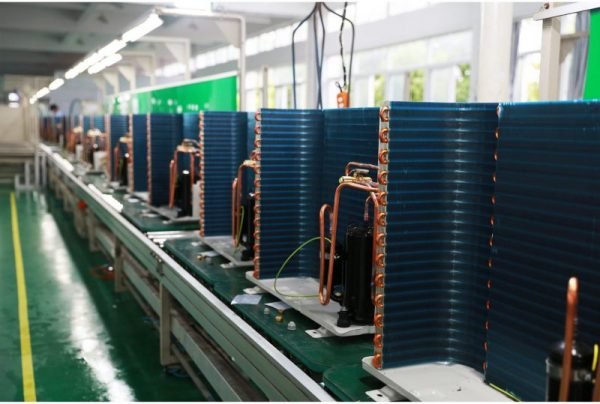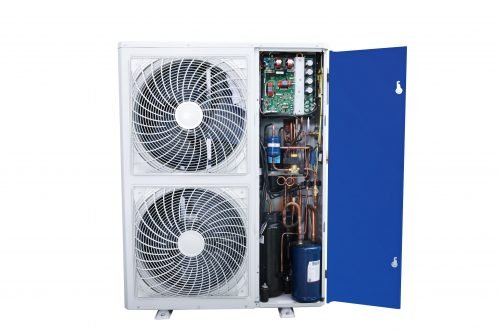Aqui estão as temperaturas comumente usadas para unidades de refrigeração. Você precisa entendê -los e prestar atenção às suas diferenças durante a manutenção diária.
Temperatura de descarga
A temperatura de descarga (Também conhecido como temperatura de escape) da unidade de refrigeração refere -se à temperatura do refrigerante quando ele sai do compressor. Este é um parâmetro crítico em sistemas de refrigeração, como reflete o estado térmico do refrigerante após a compressão. A temperatura de descarga geralmente está na faixa de 50° C ~ 120 ° C. (122° F ~ 248 ° F.).
Temperaturas de alta descarga podem indicar possíveis problemas, como:
1. Superaquecimento: Pode danificar o compressor ou levar a lubrificante degradação.
2. Nível de refrigerante incorreto: Muito ou muito pouco refrigerante pode afetar a eficiência do sistema.
3. Má troca de calor: Dissipação de calor ineficiente no condensador pode aumentar a temperatura de descarga.
4. Superheto de alta sucção: Superaquecimento excessivo na entrada do compressor pode levar a altas temperaturas de descarga.
Temperatura da concha do compressor
A temperatura da concha do compressor refere -se à temperatura da superfície externa do revestimento de um compressor durante a operação. É um indicador do calor gerado dentro do compressor como resultado do trabalho mecânico e da compactação de refrigerante.
Os principais fatores afetam Compressor Temperatura da concha
1. Carga do compressor: Cargas mais altas podem levar ao aumento do atrito e calor internos.
2. Temperatura ambiente: O ambiente circundante pode influenciar a eficiência de resfriamento do compressor.
3. Recurso de refrigerante: O tipo e a condição do refrigerante afetam as características térmicas do sistema.
4. Eficiência do sistema: Questões como baixa lubrificação, Filtros entupidos, ou resfriamento inadequado pode aumentar a temperatura da concha.
Faixas normais: A temperatura da concha varia de acordo com o projeto e o sistema, mas é menor que a temperatura de descarga. Para a maioria dos sistemas, A temperatura da concha pode variar entre 40° C ~ 90 ° C. (104° F ~ 194 ° F.). É importante permanecer dentro dos fabricantes’ Limites recomendados para evitar superaquecimento e potencial dano ao compressor.
Monitor regular A temperatura da concha pode ajudar a detectar sinais precoces de ineficiência ou falha no sistema de refrigeração.
Temperatura de condensação
Temperatura de condensação refere -se à temperatura em que o refrigerante Mudanças de vapor para status líquido no condensador durante o ciclo de refrigeração. Isso ocorre sob uma pressão específica, conhecido como pressão de condensação, que é determinado pelo design do sistema e condições de operação.
Condensação de temperatura da faixa
Condensador resfriado a ar
Necessidades de temperatura de condensação 10° C ~ 15 ° C. (18° F ~ 27 ° F.) maior que a temperatura ambiente.
Por exemplo, Se a temperatura ambiente for 30 ° C (86°F), A temperatura da condensação variará de 40° C ~ 45 ° C. (104° F ~ 113 ° F.).
Condensador resfriado a água
Necessidades de temperatura de condensação 3° C ~ 8 ° C. (5° F ~ 15 ° F.) maior que a temperatura da água de entrada.
Por exemplo, Se a temperatura de entrada de água de resfriamento for 25 ° C (77°F), A temperatura da condensação variará de 28° C ~ 33 ° C. (82° F ~ 91 ° F.).
Pontos -chave sobre a temperatura de condensação
1. Relação com rejeição de calor: A temperatura da condensação reflete o ponto em que o refrigerante libera calor ao ambiente circundante (ar ou água) no condensador.
2. Eficiência do sistema: Uma temperatura ideal de condensação é crucial para manter a eficiência do sistema. Altas temperaturas de condensação podem indicar baixa transferência de calor ou desempenho inadequado do condensador.
Temperatura da concha do condensador
A temperatura da concha do condensador refere -se à temperatura da superfície da carcaça ou da casca externa do condensador durante a operação. Esta temperatura indica com que eficácia o condensador dissipa o calor absorvido de refrigerante no ambiente circundante.
Geralmente está um pouco acima da temperatura do ar ambiente, Aproximadamente. 2° C ~ 15 ° C. (4° F ~ 27 ° F.) mais alto.
Pontos -chave sobre a temperatura da concha condensadora
1. Indicador de rejeição de calor: A temperatura da concha reflete a transferência de calor que ocorre dentro do condensador. Deve ser menor que a temperatura de condensação do refrigerante.
2. Fatores de influência:
Condições ambientais–Temperaturas mais altas de ar ambiente ou água podem aumentar a temperatura da concha em sistemas refrigerados a ar ou resfriados a água.
Eficiência do condensador–Sujeira, incrustação, ou fluxo de ar ruim pode levar a transferência de calor ineficiente e temperaturas elevadas da concha.
Pressão e carga de refrigerante–A carga excessiva do sistema ou a pressão do refrigerante pode aumentar o calor interno, afetar a temperatura da concha.
Temperatura do receptor
A temperatura do receptor refere -se à temperatura do refrigerante armazenado no receptor líquido de um sistema de refrigeração. Receptor líquido é um navio localizado após o condensador, pode armazenar e regular o suprimento de refrigerante líquido para a válvula de expansão ou outros componentes a jusante.
Pontos -chave sobre a temperatura do receptor
1. Relação com a temperatura de condensação
A temperatura do receptor está próxima da temperatura da condensação, pois o refrigerante no receptor está em um estado líquido saturado ou sub -resfriado.
Pode ser um pouco menor que a temperatura de condensação se ocorrer subconto antes que o refrigerante entre no receptor.
2. Indicador de operação do sistema
As temperaturas normais do receptor indicam operação adequada do sistema, com remoção de calor suficiente no condensador.
Temperaturas aumentadas podem sugerir problemas como resfriamento insuficiente do condensador ou condições ambientais altas.
3. Faixa de temperatura
Para sistemas refrigerados a ar, A temperatura do receptor é 5° C ~ 10 ° C. (9° F ~ 18 ° F.) abaixo da temperatura da condensação.
Para sistemas resfriados a água, A diferença pode ser menor devido à melhor eficiência de resfriamento.
Temperatura do filtro
A temperatura do filtro refere -se à temperatura do refrigerante à medida que passa pelo filtro ou Trepa de filtro em um sistema de refrigeração. Trepador de filtro é um componente usado para remover a umidade, sujeira, e outros contaminantes do refrigerante para proteger o sistema e garantir uma operação eficiente.
Pontos -chave sobre a temperatura do filtro
1. Estado de refrigerante
O refrigerante que passa pelo filtro está em um estado líquido ou sub-resfriado no lado de alta pressão do sistema.
Em alguns sistemas, Também pode lidar com refrigerante de vapor no lado de baixa pressão.
2. Faixa de temperatura normal
A temperatura do filtro deve estar próxima da temperatura líquida sub -resfriada do refrigerante.
Isso é 5° C ~ 10 ° C. (9° F ~ 18 ° F.) menor que a temperatura de condensação.
3. Indicações de temperatura anormal
A queda de temperatura no filtro pode indicar bloqueio parcial causado por sujeira, gelo, ou detritos.
O aumento da temperatura pode sugerir problemas de fluxo de refrigerante ou um componente superaquecido devido a ineficiências do sistema.
Temperatura de sucção
Temperatura de sucção (ou temperatura de entrada) refere -se à temperatura do refrigerante quando entra no compressor através da linha de sucção em um sistema de refrigeração. Esta temperatura é um parâmetro crítico para o desempenho do sistema e saúde do compressor.
Pontos -chave sobre a temperatura de sucção
1. Relação com o estado refrigerante
O refrigerante está em um estado de vapor superaquecido para garantir que nenhum refrigerante líquido entre no compressor, o que poderia causar danos.
2. Faixa de temperatura normal
A temperatura de sucção é um pouco maior que a temperatura do evaporador devido à adição de superaquecimento.
Os valores típicos de superaquecimento variam de 5° C a 15 ° C. (9° F a 27 ° F.).
3. Importância do monitor
Baixa temperatura de sucção: Indica superaquecimento insuficiente, Arredovendo refrigerante líquido entrando no compressor ( conhecido como “líquido líquido”).
Alta temperatura de sucção: Sugere superaquecimento excessivo, o que pode reduzir a eficiência do sistema e superaquecer o compressor.
Temperatura TXV
A temperatura associada a uma válvula de expansão termostática (TXV) refere -se à temperatura do refrigerante ou à área circundante que a válvula controla e detecta. O TXV regula o fluxo de refrigerante para o evaporador com base no superaquecimento do refrigerante deixando o evaporador.
Temperaturas -chave na operação de um TXV
1. Temperatura do sensor
O sensor, anexado à linha de sucção na saída do evaporador, mede a temperatura do refrigerante.
Esta temperatura determina o superaquecimento e controla o TXV aberto ou próximo para regular o fluxo do refrigerante.
Normalmente 5° C ~ 15 ° C. (9° F ~ 27 ° F.) acima da temperatura saturada do evaporador.
2. Temperatura de refrigerante na entrada do TXV
A temperatura do refrigerante que entra no TXV é a temperatura líquida sub -resfriada, que deve ser um pouco menor que a temperatura da condensação.
Geralmente 5° C ~ 10 ° C. (9° F ~ 18 ° F.) Abaixo da temperatura da condensação.
3. Temperatura de refrigerante na saída TXV
Depois de passar pelo TXV, A temperatura do refrigerante cai significativamente devido à expansão, atingindo a temperatura saturada do evaporador.
Geralmente 5° C ~ 10 ° C. (9° F ~ 18 ° F.) Abaixo da temperatura da condensação.
Temperatura de evaporação
Temperatura de evaporação (também conhecido como evaporação ou temperatura saturada) refere -se à temperatura em que o refrigerante muda de líquido para vapor dentro do evaporador de um sistema de refrigeração.
Pontos -chave sobre a temperatura de evaporação
1. Relação com o estado refrigerante
Na temperatura de evaporação, O refrigerante absorve o calor do ambiente e as transições de líquido para vapor.
2. Determinado pela pressão do evaporador
A temperatura de evaporação corresponde à temperatura de saturação à pressão fornecida dentro do evaporador. Este relacionamento depende do tipo de refrigerante usado.
Faixa de temperatura
A temperatura de evaporação é geralmente 5° C ~ 10 ° C. (9° F ~ 18 ° F.) Abaixo da temperatura alvo do meio, sendo resfriado (por exemplo., ar ou água).
Para ar-condicionado sistema, intervalo é 2° C ~ 10 ° C. (36° F ~ 50 ° F.).
Para baixa temperatura sistemas de refrigeração, pode ser tão baixo quanto -40° C ~ -10 ° C. (-40° F ~ 14 ° F.).
Temperatura ambiente ao ar livre
A temperatura ambiente ao ar livre refere -se à temperatura fora de um edifício ou sistema de refrigeração. É a temperatura externa do ambiente em que o sistema opera, e desempenha um papel significativo no desempenho do equipamento, como condensadores refrigerados a ar ou unidades externas de HVAC e sistemas de refrigeração.
Pontos -chave sobre a temperatura ambiente ao ar livre
1. Impacto no desempenho do condensador
Em sistemas refrigerados a ar, A temperatura ambiente ao ar livre afeta diretamente a eficiência do condensador. Uma temperatura ambiente mais alta pode reduzir a capacidade do condensador de rejeitar o calor, levar a pressões e temperaturas mais altas de descarga.
2. Carga do sistema
A temperatura ao ar livre influencia a carga de resfriamento geral do sistema. Por exemplo, em clima quente, As demandas de resfriamento são maiores, que pode afetar o desempenho de refrigeração e sistemas de ar condicionado.
3. Variação sazonal
A temperatura ambiente flutua com as estações, quente no verão e frio no inverno. Os sistemas devem lidar com essas variações de maneira eficaz.
4. Faixa de temperatura normal
A faixa de temperatura externa pode variar muito, dependendo da localização e das estações geográficas, mas normalmente, pode variar de -10°C (14°F) no inverno para +40°C (104°F) ou superior durante o verão em muitas regiões.
5. Importância no dimensionamento e operação do sistema
Os engenheiros consideram a temperatura ambiente ao ar livre quando o projeto HVAC e os sistemas de refrigeração para garantir que possam operar com eficiência em condições de alta e baixa temperatura.
Conclusão
Essas temperaturas são influenciadas por fatores como condições ambientais, Design do sistema, Tipo de refrigerante,etc.
Seleção e manutenção adequadas As temperaturas são cruciais para otimizar a eficiência energética, garantindo a longevidade do sistema, e atender aos requisitos específicos de resfriamento ou congelamento.
Algum comentário?
Bem-vindo deixe uma mensagem ou repost.














